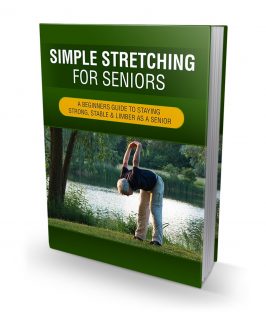 License Type: Master Resell Rights
License Type: Master Resell Rights  File Type: ZIP
File Type: ZIP
 SKU: 63101
SKU: 63101  Shipping: Online Download
Shipping: Online Download
Sample Content Preview
Introduction
Hello and welcome to our short, introductory guide on simple stretching techniques to keep stable & limber for seniors.
As you get older, your body will go through a lot of changes. Your hair will turn grey or white, your skin will become wrinkled, and your body will become stiff as you suffer from joint, muscle, and bone problems. For many years, we’ve accepted that stiffening of the joints and tightening of the muscles were a natural part of aging, but new research suggests otherwise.
Research has now found that at least half of the changes aging people experience in regards to their joints, muscles, and bones are a direct result of a lack of activity.
However, when less than 10 percent of people over the age of 50 aren’t getting enough exercise to maintain their health at the very least, it’s no wonder that so many people have accepted their fates as normal.
Bone and Muscle Problems in the Aging Body
The most common bone and muscle problems the aging body may experience include osteoarthritis when the cartilage in your joints begins to break down, osteomalacia which is a softening of the bones, osteoporosis that leads to brittle bones when bones lose their mass, rheumatoid arthritis which is an inflammation in the joints, and general muscle weakness and pain.
Muscle Changes
As we age, there are a few changes that our muscles go through that lead to the above problems. Our muscle fibers become smaller and we have less of them, and nervous system changes lead to less muscle tone and a decreased ability to contract muscles. Lost muscle tissue is regenerated more slowly than before and the tissue that replaces it is often tough and fibrous.
Bone Changes
We don’t often think of bones as living tissue, but they absolutely are, and also go through changes as we age. Our bones begin to lose more calcium and other important minerals because of the hormonal changes that occur as we age. Women are especially vulnerable after they’ve gone through menopause, but men are also affected by bone loss that occurs with age.
Joint Changes
The movement in our joints is a result of the movement of ligaments, the flowing of synovial fluid which surrounds your joints, and layers of cartilage that keeps bones from coming into direct contact with each other. However, in the aging body, ligaments can become shorter and less flexible, there is less synovial fluid to lubricate joints, and cartilage thins. All of this leads to stiffening in the joints.
How This Guide Can Help You
A surprising number of these age-related conditions can be reversed or prevented by doing regular exercise and stretching exercises. This course specifically focuses on how to use stretching as a way to maintain limberness and flexibility no matter how old you are. The truth is, it’s never too late to start doing something for your body.
By the end of this guide, you will have all the tools you need to keep your body in the best possible shape so you can enjoy your golden years
Chapter 1 – An Overview Of Stretching The Aging Body And Basic Anatomy
The primary goal of stretching the aging body is to prevent muscles and joints from becoming stiff from disuse. By regularly stretching your muscles and flexing your joints, you can help prevent many of the age-related conditions that affect the joints, muscles, and bones of an aging body. In this part of the guide, we’re going to go over the major muscle groups and joints that are most important to keep limber.
The 11 Major Muscle Groups
There are 11 major muscle groups that you want to make sure you’re using regularly and keeping stretched out. If you are also doing strength training exercises, these are the same muscle groups that you will be working out with that.
Forearms – Your lower arm has several muscles that are particularly important for lifting and holding objects.
Biceps – A large muscle found in each of your upper arms, your biceps help your forearms with lifting things.
Triceps – These are the other 2 muscles that are found in your upper arms. They help your body extend and bend your elbow.
Shoulders – There are a number of muscles on your front, back, and side that make up the shoulders which are responsible for arm movement.
Trapezius – Often referred to as traps, these are the muscles in your upper back that helps move your neck, head, and shoulder blade.
Chest – This group of muscles that covers your ribcage is responsible for helping with arm movement and breathing.
Abdominals – This important group of muscles located in your abdomen help with breathing and support your spine. They are often referred to as abs or your core muscles.
Back – One of the biggest muscle groups, your back muscles help support your spine and are a part of hip movement.
Quadriceps – These are the four muscles that are found at the front of your thigh and are a vital part of leg movement as they help control the hip and knee movements.
Hamstrings – The group of muscle that makes up the back of your thigh and help with the movement of the hip and knee as well.
Calves – The muscles found in your lower leg are what help you move your knee and flex your ankle.
The 7 Major Joints
Although you have a number of smaller joints in your fingers and toes, there are 7 major joints in the rest of your body that we’re going to cover. Every joint is made up of a combination of muscles that provide the movement, ligaments and tendons that connect bones and muscles, and bones.
Spine – Your spine helps support your upper body and houses the nerves that run to every body system. It’s made up of a number of individual vertebrae.







